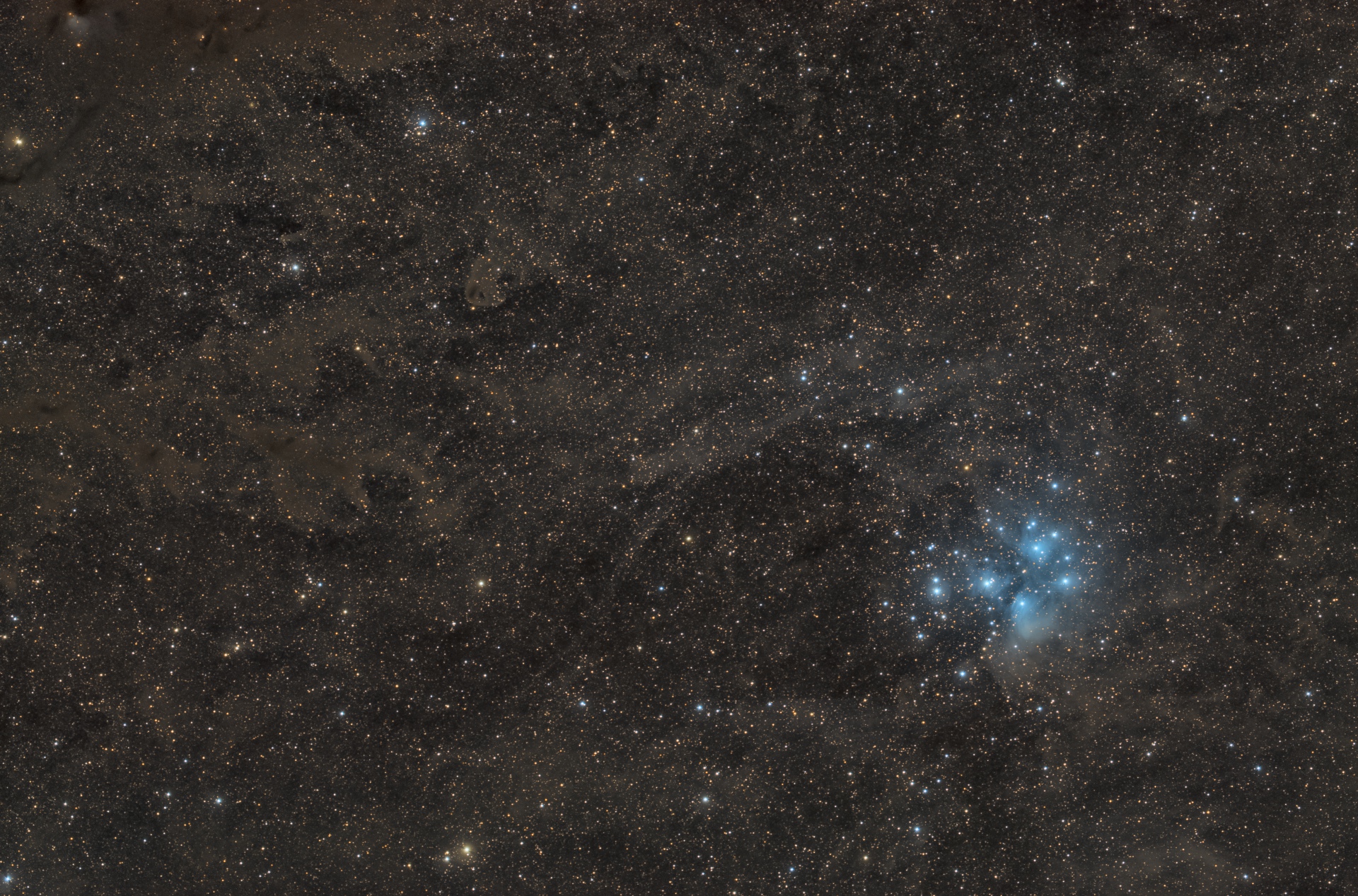
After over a year attempting to shoot this region I’ve finally completed a revision of the dark molecular clouds that cover the taurus region near the Pleiades. This is but one panel of a larger 8-panel mosaic that I’ve planned and hope to complete before summer gets here. But this region in particular is one that I am a huge fan of. it is home to the very popular and bright star cluster M45 the Pleiades that sits behind the molecular cloud, but it’s radience shines through the dust. Through the dust structures one can find LBN777, a “ghost like” molecular cloud that to my eyes looks like it’s about to eat that bright yellow nearby star is more commonly known as the Vulture Nebula or Baby Eagle Nebula.
Follow Me on Instagram | Astrobin
Equipment:
Celestron CGEM Mount
Self tuned / hacks to get guiding stable include:
Intentional offset polar alignment so dec always pulses in one direction
Balance “west” heavy (rather than the recommended east) so that the ota “falls” onto the gear teeth rather than get “lifted”
Factor Reset hand-controller daily (to prevent cgem from being possessed and forgetting where the meridian is on subsequent night)
Dither in RA only
Rokinon 135mm f2 at f2
asi071mc PRO at -15 C
Astronomiks L3 UV/IR filter
Widefield Rig + AF3 by Deep Sky Dad
Acquisition:
- 123x120s at unity gain (4 hours) taken across four nights in 2019 Dec: 01 - Dec 04. The Moon went from 20%-50% illuminated during these nights but all data taken while moon was below or near the horizon.
Session sequenced using Nighttime Imaging in Astronomy: N.I.N.A
All pre-processing and post-processing was done in PixInsight and final touches added with Affinity photo. Full details below.
The resulting image is a combination of the following steps:
Inspected all subs for bad images with Blink, discarding subs containing clouds
Calibrated all subs with a master flat and master dark
Used subframe selector to weight all images based on the following weighting
1 |
|
Selected the best sub from subframe and blink to use as a reference frame for aligning and integration
Cropped the stacking edges of the integrated image
Dynamic Background Extraction
Background Neutralization using 5 small preview windows aggregated as a background reference
Color Calibration |> Solved |> Photometric Color Calibration
RGBWorking Space to 1,1,1
Noise Reduction was done using TGV Denoise with a low contrast mask and an autostretched local support and MMT with a very protective luminance mask
Stretched using Arcsinh Stretch followed by Masked Stretch
Luminance Processing
A synthetic luminance was extracted prior to the stetching of the RGB data for separating luminance processing
LStretched using Masked Stretch and Histogram Transformation
Created a
Starlessversion of the luminance using starnet++ and a StarsOnly image by subtracting the starless from the luminanceStarless-LPerformed two rounds of Local Histogram Equalization on the starless image
Kernel Radius 128 | Contrast 4 | Amount 0.100 | 8-bit | Circular
Kernel Radius 256 | Contrast 8 | Amount 0.030 | 8-bit | Circular
Performed large scale sharpening and noise reduction with Multiscale Linear Transformation 6 levels
Recombined the enhanced Starless with the Stars only image with Pixel Math
Starless+StarsOnly
Bringing the Enhanced Details back into the Color Data and Final Steps
Used ChannelCombination in CIE L*A*B mode to apply Luminance to Color
Stars in this image were reduced by using two rounds of morphological selection with a luminance based contours mask created with the following steps:
Extract a new luminance from the color image
Apply the following pixel math expression to a new extracted luminance to create a contours version using the
StarsOnlyimage created earlier:StarsOnly/$T-$T
Curves transformation was used to increase contrast and saturation with a luminance mask
Over saturated stars were magenta and were fixed by inverting and applying SCNR green before re-inverting
An ICC Profile was applied to enable Black Point Compensation
The image was exported as a 16bit TIFF file and loaded into Affinity Photo
Final round of noise reduction was applied with Affinity
HSL enhancements were applied to shift the dust colors to emphasize their golden brown color
The final image from Affinity Photo and the final image from PixInsight was blended together to ensure a more natural reduction of noise levels
Constructive criticism is welcome. Let me know what you think! How can I improve?